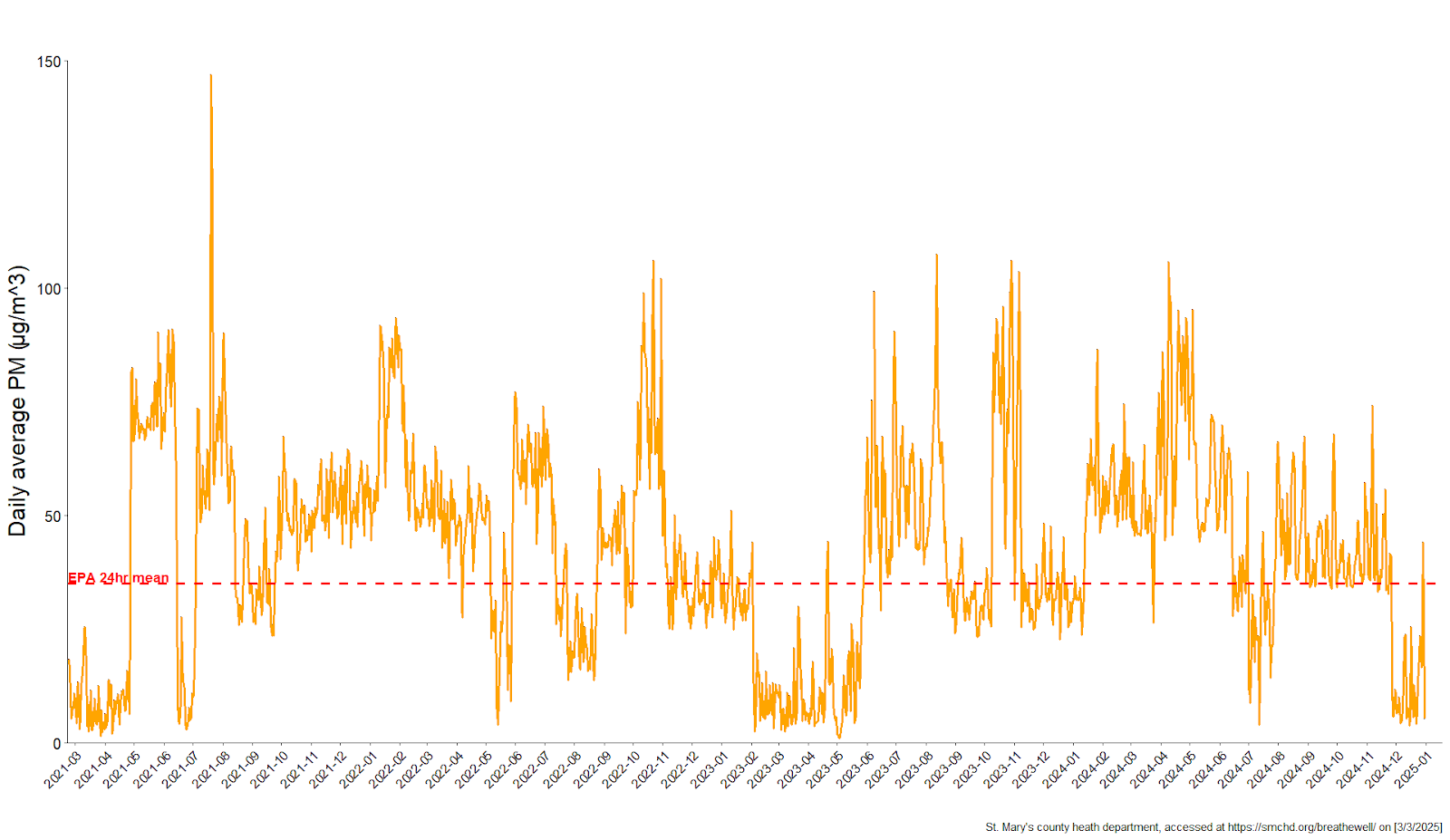
BreatheWell St. Mary’s is an air quality monitoring and health initiative focused on improving community well-being. By installing outdoor sensors across the county, it tracks pollutants like particulate matter, ozone, and nitrogen dioxide, which can affect respiratory health. St. Mary’s County Health Department provides real-time air quality data and offers health tips to help residents take protective actions.
St. Mary’s County Air Quality Dashboard
Get real-time updates on air quality conditions across St. Mary’s County. Our dashboard monitors key pollutants like particulate matter, ozone, and nitrogen dioxide to help you stay informed. Whether you’re planning outdoor activities or managing respiratory conditions, this tool provides instant insights into the air you’re breathing. Use it to take immediate protective actions when pollution levels are high. Stay safe and breathe easy with our real-time data and health recommendations.
St Mary’s County Air Quality Trailer
The St. Mary’s County Air Quality Trailer is a mobile monitoring unit that provides detailed, real-time data on local air quality. Equipped with advanced sensors, it measures pollutants like ozone, particulate matter, and nitrogen dioxide to assess air quality conditions. This information helps identify pollution trends, pinpoint areas with elevated risks, and support local health initiatives. The trailer also plays a key role in community outreach and education, raising awareness about the importance of air quality for public health.
Click here to access live air quality data directly from the St. Mary’s County Air Quality Trailer, offering real time pollutant readings based on its current location.
Daily average PM2.5 in St. Mary’s County
The graph illustrates the daily average PM2.5 levels in St. Mary’s County, providing insights into air quality trends over time. PM2.5 refers to fine particulate matter that can pose health risks when levels are elevated. The data highlights fluctuations influenced by factors such as weather conditions, seasonal changes, and potential pollution sources. Spikes in the graph may indicate events like wildfire smoke or increased vehicle emissions, while lower values suggest cleaner air days.

Exceedance days in St. Mary’s County
The graph displays the number of exceedance days in St. Mary’s County, indicating how often air quality levels surpass regulatory standards for pollutants like PM2.5 or ozone. Exceedance days occur when pollutant concentrations exceed safe thresholds set by the EPA, posing potential health risks, especially for sensitive groups such as children, the elderly, and individuals with respiratory conditions. Trends in the graph may reflect seasonal patterns, environmental changes, or pollution events. Monitoring these exceedances helps assess air quality progress and guides efforts to reduce pollution and protect public health.

Average PM2.5 levels in St. Mary’s County
The graph illustrates the average PM2.5 levels in St. Mary’s County, providing a measure of fine particulate matter in the air over time. PM2.5 consists of tiny particles that can penetrate deep into the lungs, affecting respiratory and cardiovascular health. The data highlights trends in air quality, with higher levels potentially linked to factors such as vehicle emissions, industrial activity, and seasonal changes like wildfire smoke. Monitoring these levels helps track progress toward cleaner air and informs strategies to reduce pollution and protect public health.

Maryland Air Quality
Air quality in Maryland has significantly improved over recent decades, but pollution remains a health concern. Exposure to pollutants like ozone and fine particles can lead to short- and long-term health problems such as asthma and heart disease. Monitoring air quality is critical for understanding pollution trends, identifying high-risk areas, and evaluating health impacts on local communities. Through continuous tracking, we can better protect public health and reduce exposure to harmful air pollutants.
Click here for detailed data on Maryland’s air quality, including pollutant levels, trends, and regional health impacts.
Air Quality Blog
How Air Quality Monitors Help Develop Greener Buildings
In the ever-evolving landscape of sustainable architecture and construction, the quest for greener buildings continues. As environmental concerns take center stage, a fundamental aspect of this pursuit lies in ensuring the health and well-being of occupants. So begins the conversation of air quality in architecture. Many people wonder, do buildings cause air pollution? […]
Over 14,000 PurpleAir Air Quality Monitors Tested Against FEM/FRM Monitors
Scientists are raising concerns about low-cost air quality monitor. While these residential air quality monitors allow anyone to access air quality data, they can also be unreliable. Substandard air quality monitors can produce misleading information, putting communities and families at risk of air pollution-related illnesses. Additionally, it can lead to inaccurate studies and theories on air quality. So, how can you find an affordable air quality monitor you can trust? An air quality study tested the accuracy of over 14,000 PurpleAir air quality monitors against professional-standard FEM/FRM methods. And we’re discussing all about it in this article. […]
How PurpleAir Air Quality Data is Aiding NASA Research
How do you know if your air quality is good or bad? While you can use your nose and eyes to determine air quality, doing so isn’t always reliable. Air pollutants, like Particulate Matter (PM) are sometimes odorless and invisible to the naked eye—especially in low concentrations. As such, you won’t know you’re breathing in dangerous levels of air pollution until it has invaded your body. To effectively know your air quality, you need air quality data. But there is still much to learn beyond our current knowledge of air quality. Thankfully, NASA is launching the satellites MAIA and TEMPO to further study air quality and its impact on human health and the environment. […]